Coronaviruses are named for the crown-like spikes on their surface. There are four main sub-groupings of coronaviruses, known as alpha, beta, gamma, and delta. Novel coronavirus (SARS-CoV-2, previously known as 2019-nCoV) is a beta coronavirus. SARS-CoV-2 is a positive-sense, single-stranded RNA coronavirus that causes COVID-19, the infectious disease that can cause an acute respiratory infection. Studies show that the SARS-CoV-2 S protein retains sufficient affinity to the cellular Angiotensin converting enzyme 2 (ACE2) protein, and likely uses ACE2 protein as a receptor for cellular entry.
There is currently no specific medicine or treatment for diseases caused by SARS-CoV-2. To identify antiviral candidates, scientists are focused on drug repurposing and antiviral molecules screening from chemical libraries. We offer efficient compound libraries to assist in the global efforts to develop novel drug candidates, such as FDA-approved Drug Library and Anti-Virus Compound Library. We also offer reverse transcription and qPCR series to help efficiently detect SARS-CoV-2, and mRNA in vitro synthesis platform to support the development of mRNA vaccines.
1.Inhibitors related to 2019-nCoV
APExBIO, as a professional supplier of small molecule inhibitors, provides a variety of inhibitors related to 2019-nCoV, found so far.
| Catalog No. | Product | Description | References |
| B4874 | Hydroxychloroquine Sulfate | Hydroxychloroquine Sulfate is a synthetic quinine derivative commonly used as an antimalarial drug. It is also useful in managing systemic lupus erythematosus, rheumatoid arthritis, and other diseases. Also acts as an inhibitor of autophagy and toll-like receptor 7/9(TLR7/9). | Hydroxychloroquine and azithromycin as a treatment of COVID-19: results of an open-label non-randomized clinical trial |
| A1933 | Carfilzomib (PR-171) | An epoxomicin derivate with potential antineoplastic activity. It irreversibly binds to and inhibits the chymotrypsin-like activity of the 20S proteasome, an enzyme responsible for degrading a large variety of cellular proteins. | Hydroxychloroquine and azithromycin as a treatment of COVID-19: results of an open-label non-randomized clinical trial |
| B4950 | Darunavir Ethanolate | Darunavir Ethanolate is a human immunodeficiency virus (HIV) protease inhibitor. | Many drugs already approved by FDA may have promise against COVID-19 |
| B2285 | Daunorubicin HCl | Daunorubicin HCl is an inhibitor of DNA topoisomerase II. Daunorubicin is an anthracycline antibiotic. it can affect the metabolism and synthesis of DNA and RNA. | Many drugs already approved by FDA may have promise against COVID-19 |
| A8628 | Chloroquine diphosphate | Chloroquine diphosphate is used as an antimalarial drug and also functions to increase sensitivity of tumor cells to radiation and chemotherapy via inducing autophagy. | Remdesivir and chloroquine effectively inhibit the recently emerged novel coronavirus (2019-nCoV) in vitro |
| B8398 | Remdesivir (GS-5734) | Remdesivir (GS-5734) is an antiviral nucleoside analogue that inhibits murine hepatitis virus (MHV) with similar EC50 as SARS-CoV and MERS-CoV. | Remdesivir and chloroquine effectively inhibit the recently emerged novel coronavirus (2019-nCoV) in vitro |
| A8504 | Pitavastatin Calcium | Pitavastatin Calcium is a competitive inhibitor of the enzyme HMGCR (HMG-CoA reductase) results in a reduction in LDL cholesterol synthesis. | Potential COVID-2019 3C-like Protease Inhibitors Designed Using Generative Deep Learning Approaches |
| A8458 | Lamivudine | Lamivudine, a nucleoside analog, is a potent reverse transcriptase inhibitor, with IC50 value of 0.316 µM against human immunodeficiency virus type 1 (HIV-1). | COVID-19 Registered Trials – and analysis |
| A8204 | Lopinavir | Lopinavir (also known as ABT-378) is a highly potent inhibitor of human immunodeficiency virus (HIV) protease that potently inhibits wild-type and mutant HIV protease with inhibition constant Ki values ranging from 1.3 to 3.6 pM. | Clinical characteristics and therapeutic procedure for four cases with 2019 novel coronavirus pneumonia receiving combined Chinese and Western medicin |
| B2114 | Mitoxantrone HCl | Mitoxantrone is a Topoisomerase II inhibitor, an anti-neoplastic drug for leukemia and other types of cancer, and a proven drug for multiple sclerosis. | Many drugs already approved by FDA may have promise against COVID-19 |
| A3653 | Nelfinavir Mesylate | Nelfinavir Mesylate is a potent inhibitor of HIV-1 protease. | Potential COVID-2019 3C-like Protease Inhibitors Designed Using Generative Deep Learning Approaches |
| A8203 | Ritonavir | Ritonavir, previously known as ABT-538, is a potent inhibitor of human immunodeficiency virus type 1 (HIV-1) protease that exhibits potent in vitro inhibition against HIV-1 strain as well as HIV-2 strain. | Clinical characteristics and therapeutic procedure for four cases with 2019 novel coronavirus pneumonia receiving combined Chinese and Western medicin |
| A5275 | Tenofovir | Selectively inhibits HIV reverse transcriptase (RNA-dependent DNA polymerase). Prevents cytotoxicity in SIV-infected C-8166 cells in vitro (IC50 = 1.5 μM). Antiviral agent. | COVID-19 Registered Trials – and analysis |
| B1123 | Rosuvastatin | Rosuvastatin is an inhibitor of HMG-CoA reductase, an enzyme that catalyzes the rate-limiting step in cholesterol biosynthesis, with Ki value (inhibition constant) of approximately 0.1 nM. | Many drugs already approved by FDA may have promise against COVID-19 |
| A8206 | Darunavir | Darunavir is a nonpeptidic HIV protease inhibitor, used to treat HIV infection. | Many drugs already approved by FDA may have promise against COVID-19 |
| A3546 | Ledipasvir (GS5885) | Ledipasvir is an inhibitor of the hepatitis C virus replication with IC50 value of 141 nM. | Prediction of the SARS-CoV-2 (2019-nCoV) 3C-like protease (3CL pro) structure: virtual screening reveals velpatasvir, ledipasvir, and other drug repur |
| A4031 | Telaprevir (VX-950) | Telaprevir (also known as VX-950), derived from the viral NS5A/5B substrate of the protease through structure-based techniques, is a novel and potent inhibitor of hepatitis C virus (HCV) NS3-4A protease, which covalently and reversibly inhibit the NS3-4A protease via a slow-binding and slow-dissociation mechanism. | α-Ketoamides as Broad-Spectrum Inhibitors of Coronavirus and Enterovirus Replication: Structure-Based Design, Synthesis, and Activity Assessment |
| A4024 | Danoprevir (R7227) | Danoprevir (R7227) is a potent and selective inhibitor of Hepatitis C Virus (HCV) NS3/4A protease. | First Clinical Study Using HCV Protease Inhibitor Danoprevir to Treat Naive and Experienced COVID-19 Patients |
| A8518 | Rosuvastatin Calcium | A selective, competitive inhibitor of HMG-CoA reductase, that is also antilipemic. | Many drugs already approved by FDA may have promise against COVID-19 |
| B2078 | Atovaquone | Atovaquone is a medication used to treat or prevent for pneumocystis pneumonia, toxoplasmosis, malaria, and babesia. | Many drugs already approved by FDA may have promise against COVID-19 |
| B2011 | Praziquantel | Praziquantel is an anthelmintic effective against flatworms. | Potential COVID-2019 3C-like Protease Inhibitors Designed Using Generative Deep Learning Approaches |
| A3261 | Boceprevir | Boceprevir is a potent and selective inhibitor of hepatitis C virus (HCV) protease NS3 with Ki value of 14 nM. | α-Ketoamides as Broad-Spectrum Inhibitors of Coronavirus and Enterovirus Replication: Structure-Based Design, Synthesis, and Activity Assessment |
| P10019 | Prulifloxacin (NM441) | Prulifloxacin is a precursor drug of ulifloxacinand and a broad-spectrum quinolone antibacterial. | Potential COVID-2019 3C-like Protease Inhibitors Designed Using Generative Deep Learning Approaches |
| B2212 | Moexipril HCl | Moexipril HCl is a potent orally active non-sulfhydryl angiotensin converting enzyme(ACE) inhibitor, which is used for the treatment of hypertension and congestive heart failure. | Many drugs already approved by FDA may have promise against COVID-19 |
| B1569 | Bepotastine Besilate | Bepotastine Beslilate (Bepreve) is a histamine H1 receptor anatagonist. | Many drugs already approved by FDA may have promise against COVID-19 |
2. Screening Libraries
| Cat.No. | Product Name | Information |
| L1021 | FDA-approved Drug Library | 1971 FDA-approved drugs |
| L1022 | Bioactive Compound Library | 3317 bioactive compounds |
| L1022P | Bioactive Compound Library Plus | 4417 bioactive compounds |
| L1050 | Anti-Virus Compound Library | 264 anti-virus compounds |
| L1039 | Natural Product Library | 550 natural products |
| L1039P | Natural Product Library Plus | 1170 natural products |
| L1027 | Anti-infection Compound Library | 367 anti-infection small molecules |
| L1027P | Anti-infection Compound Library Plus | 663 anti-infection small molecules |
| L1035 | Protease Inhibitor Library | 825 protease inhibitors |
| L1026 | Neuronal Signaling Library | 556 neuronal signaling-related small molecules |
| L1026P | Neuronal Signaling Compound Library Plus | 948 neuronal signaling-related small molecules |
| L1024 | Kinase Inhibitor Library | 796 kinase inhibitors |
| L1023 | Anti-cancer Compound Library | 1164 anti-cancer compounds |
| L1023P | Anti-cancer Compound Library Plus | 1777 anti-cancer compounds |
| L1025 | GPCR Compound Library | 677 GPCR-related small molecules |
| L1029 | Epigenetics Compound Library | 328 epigenetics-related small molecules |
| L1034 | PI3K/Akt/mTOR Compound Library | 178 PI3K/Akt/mTOR inhibitors |
| L1041 | JAK/STAT Compound Library | 109 JAK/STAT inhibitors |
| L1028 | Tyrosine Kinase Inhibitor Library | 369 tyrosine kinase inhibitors |
| L1031 | Autophagy Compound Library | 486 autophagy-related compounds |
| L1031P | Autophagy Compound Library Plus | 837 autophagy-related compounds |
| L1032 | Metabolism-related Compound Library | 493 metabolism-related compounds |
| L1032P | Metabolism-related Compound Library Plus | 1205 metabolism-related compounds |
| L1036 | Apoptosis Compound Library | 643 apoptosis-related compounds |
| L1038 | Histone Modification Library | 157 histone modification-related compounds |
| L1040 | Stem Cell Compound Library | 169 stem cell-related compounds |
| L1040P | Stem Cell Compound Library Plus | 280 stem cell-related compounds |
| L1042 | Immunology/Inflammation Compound Library | 295 immunology/inflammation-related small molecules |
| L1042P | Immunology/Inflammation Compound Library Plus | 806 immunology/inflammation-related small molecules |
| L1043 | MAPK Inhibitor Library | 117 MAPK inhibitors |
| L1048 | Inhibitor Library | 2525 inhibitors |
| L1033 | DNA Damage/DNA Repair Library | 481 DNA Damage/DNA repair-related compounds |
| L1037 | Cell Cycle Library | 449 cell cycle-related compounds |
| L1045 | TGF-beta/Smad Compound Library | 88 TGF-beta/Smad inhibitors |
| L1030 | Ion Channel Compound Library | 199 ion channel-related compounds |
| L1030P | Ion Channel Compound Library Plus | 350 ion channel-related compounds |
| L1044 | NF-κB Signaling Library | 73 NF-κB inhibitors |
| L1044P | NF-κB Signaling Compound Library Plus | 178 NF-κB inhibitors |
| L1046 | Anti-diabetic Compound Library | 110 anti-diabetic small molecules |
| L1047 | Angiogenesis Library | 84 angiogenesis-related small molecules |
| L1049 | Ubiquitination Compound Library | 144 ubiquitination compounds |
We also offer customized screening libraries that allow you to choose the compounds, the sizes, the quantities, the format (powder or solution) and plate map you want in the library.
3. Reverse Transcriptase, qPCR Series

qPCR amplification curve of SARS-CoV-2 S gene. The initial number of copies of template DNA: 10/20/200 copies. The DNA was quantified using 2X SYBR Green qPCR Master Mix (Cat. No. K1070).
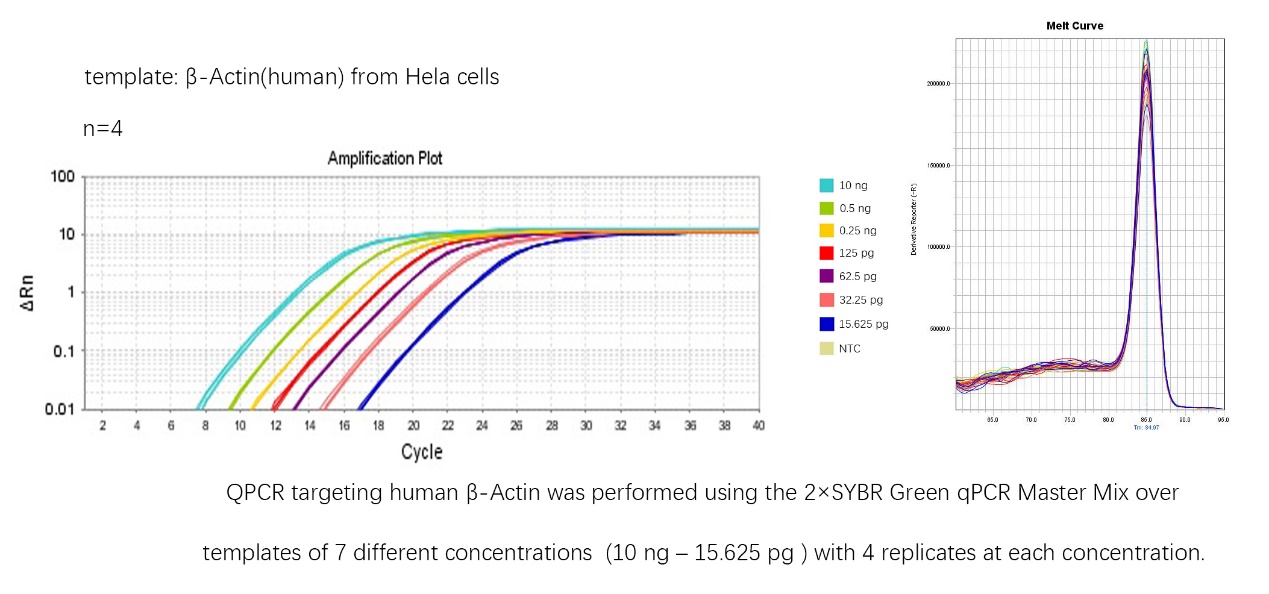
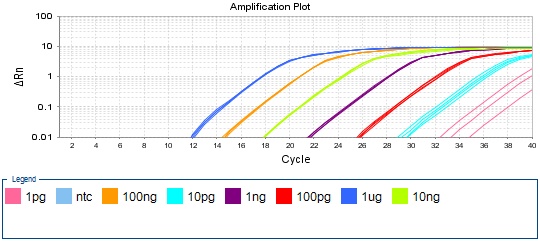
qPCR amplification curve of human β-Action. RNA was extracted from 293A cells and diluted to 7 different concentrations (1μg/μl, 100ng/μl, 10ng/μl, 1ng/μl, 100pg/μl, 10pg/μl, 1pg/μl). Reverse transcription was performed using First-Strand cDNA Synthesis SuperMix (Cat. No. K1073) to obtain cDNA products. The cDNA was then quantified using 2X SYBR Green qPCR Master Mix (Cat. No. K1070).
| Cat.No. | Product Name | Information |
| K1070 | 2×SYBR Green qPCR Master Mix | 2X PreMix for quantifying target DNA or cDNA |
| K1071 | Reverse Transcriptase | Thermally stable reverse transcriptase used to synthesize complementary DNA (cDNA) from an RNA template |
| K1072 | First-Strand cDNA Synthesis Kit | Synthesize first-strand cDNA from purified poly(A)+ or total RNA |
| K1073 | First-Strand cDNA Synthesis SuperMix | Reverse transcription reaction premixed solution for efficient synthesis of first-strand cDNA |
| K1074 | RT SuperMix for qPCR | High efficiency reverse transcription reaction premixed solution for two-step RT-qPCR method |
| K1046 | RNase Inhibitor, Murine | RNase Inhibitor, Murine specifically inhibits RNases A, B and C to protect RNA from degradation |
4. RNA In Vitro Synthesis Platform
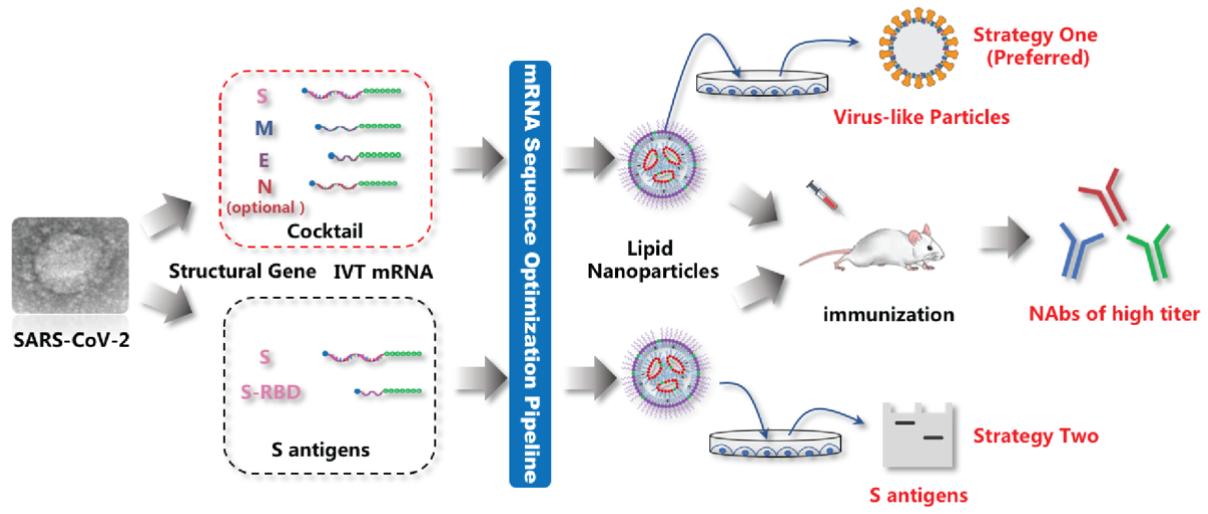
An overview of the workflow developing mRNA vaccines against 2019-nCoV. Both receptor-binding domain of the spike protein (S-RBD) and Virus like particles (VLPs) were chosen as the antigen. Strategy one: Based on the mRNA in vitro transcription platform, SARS-CoV-2 S, M, E mRNA were synthesized in vitro and individually transfected into 293T cells by using lipofectamine 2000. Virus like particles (VLPs) were produced and used as the presenting antigen. VLPs synthesized by the host cells have the same posttranslational modifications as the native virus, which is an important factor determining the validity of an antigen. Strategy two: For the S-RBD antigen, the RBD domain of the S protein was also expressed in cells using in vitro transcription (IVT) mRNA. (Ref.1)
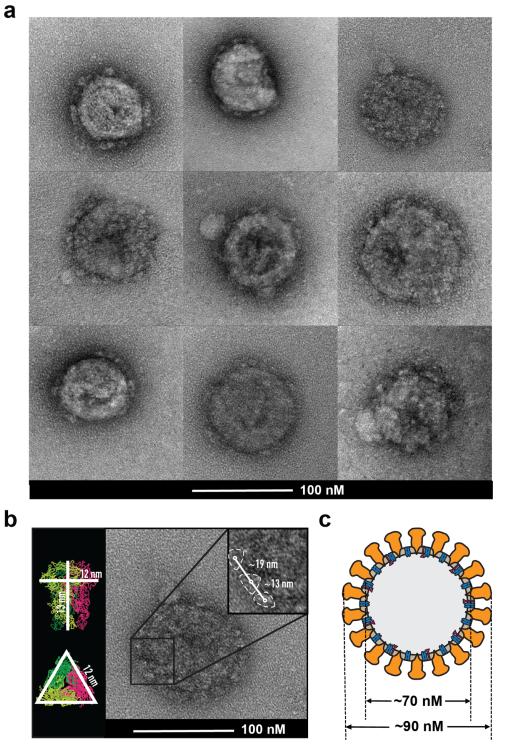
VLPs were visualized under an electron microscope. We observed particles with striking features of coronavirus. The outline of the envelope for most particles was clear, the spikes were visible. The average size of the particle is 70nm in diameter for the membrane envelope and 90nm when including the spikes, consistent with reported native 2019-nCoV virus. (Ref.1)

The trimeric structure of the extra-vesicular domain of the spike protein from SARS-CoV. The receptor-binding domain (RBD) was used as the antigen. Use mRNA to express the receptor-binding domain of the spike protein (S-RBD). The S glycoprotein is responsible for binding to the receptor through its RBD, enabling the virus to enter into target cells by fusing with cell membranes. The western blot analysis was used to confirm the expression of target proteins. (Ref.1)
Reference:
1.Towards an effective mRNA vaccine against 2019-nCoV: demonstration of virus-like particles expressed from an modified mRNA cocktail.
Affordable Cost, High Yields
APExBIO offers affordable custom synthesis of mRNA and long RNA (up to multiple kilobases) with a wide array of modification services at scales ranging from micrograms to milligrams. The mRNA can be generated from DNA templates provided by our customers or we can provide a full service from the ground up. We provide mCAP, ARCA and EZ Cap (equal to CleanCap) capping or modified nucleotides implication for all our standard mRNA transcripts.
For ordering and more information, please download this form (Custom mRNA Synthesis Questionnaire.PDF) and send it via email (sales@apexbt.com). Our support team will review and provide a quotation soon.
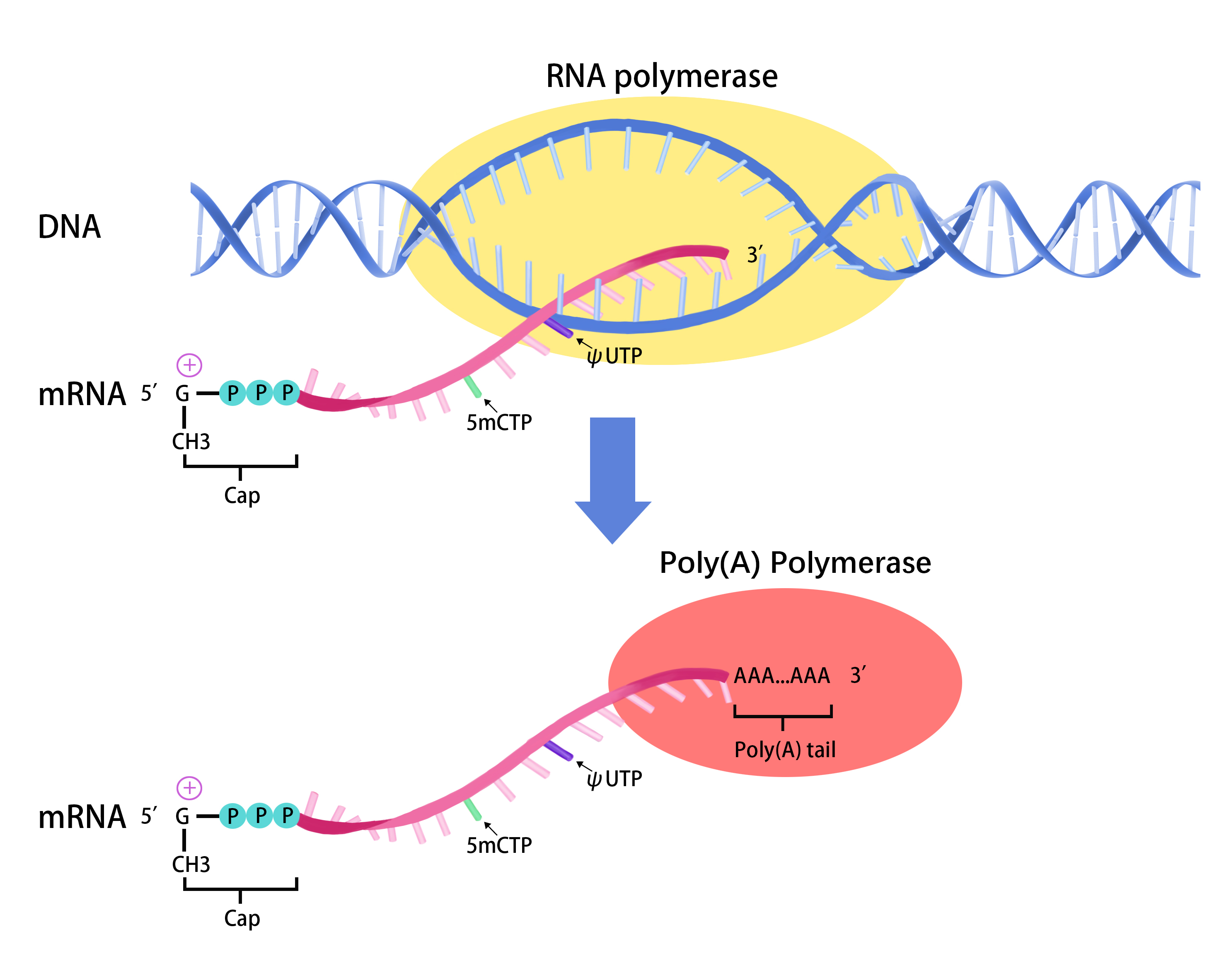
Modified Nucleotide-containing mRNA Synthesis
In Vitro Synthesis of mRNA (In vitro transcription, IVT)
A 7-methyl guanosine (m7G) cap structure at the 5′ end and a poly(A) tail at the 3′ end are required for mRNA to be translated efficiently in vitro. Capped mRNAs are synthesized by co-transcriptional incorporation of Anti-Reverse Cap Analog (ARCA) via T7 RNA Polymerase. DNase I is used to remove the template DNA, so Poly(A) Polymerase can attach poly(A) tail to capped mRNA. 5-Methyl-CTP, Pseudo-UTP and other modified nucleotides can also be incorporated into mRNA. Synthetic mRNAs are applicable in cell transfection, microinjection, in vitro translation and RNA vaccines etc.
Our custom synthesis mRNA covers a wide range of applications:
Validation:
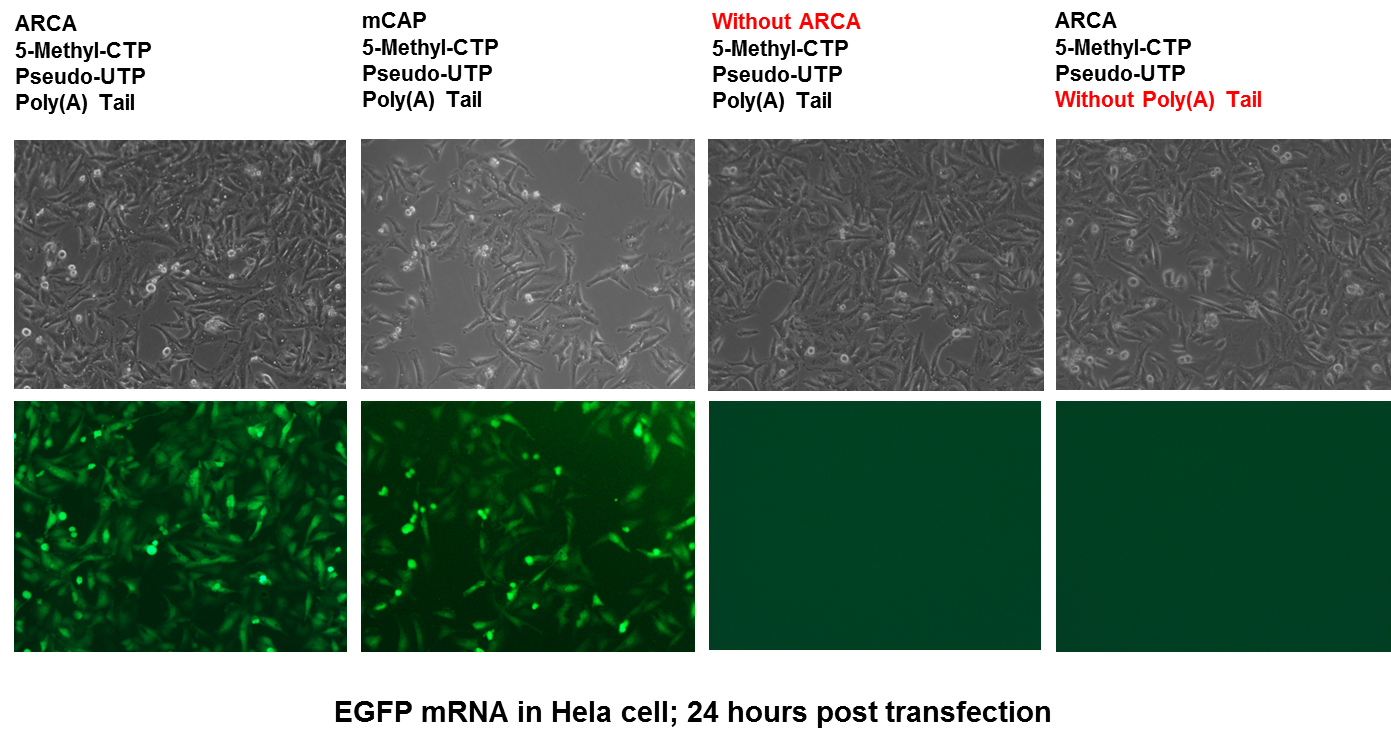
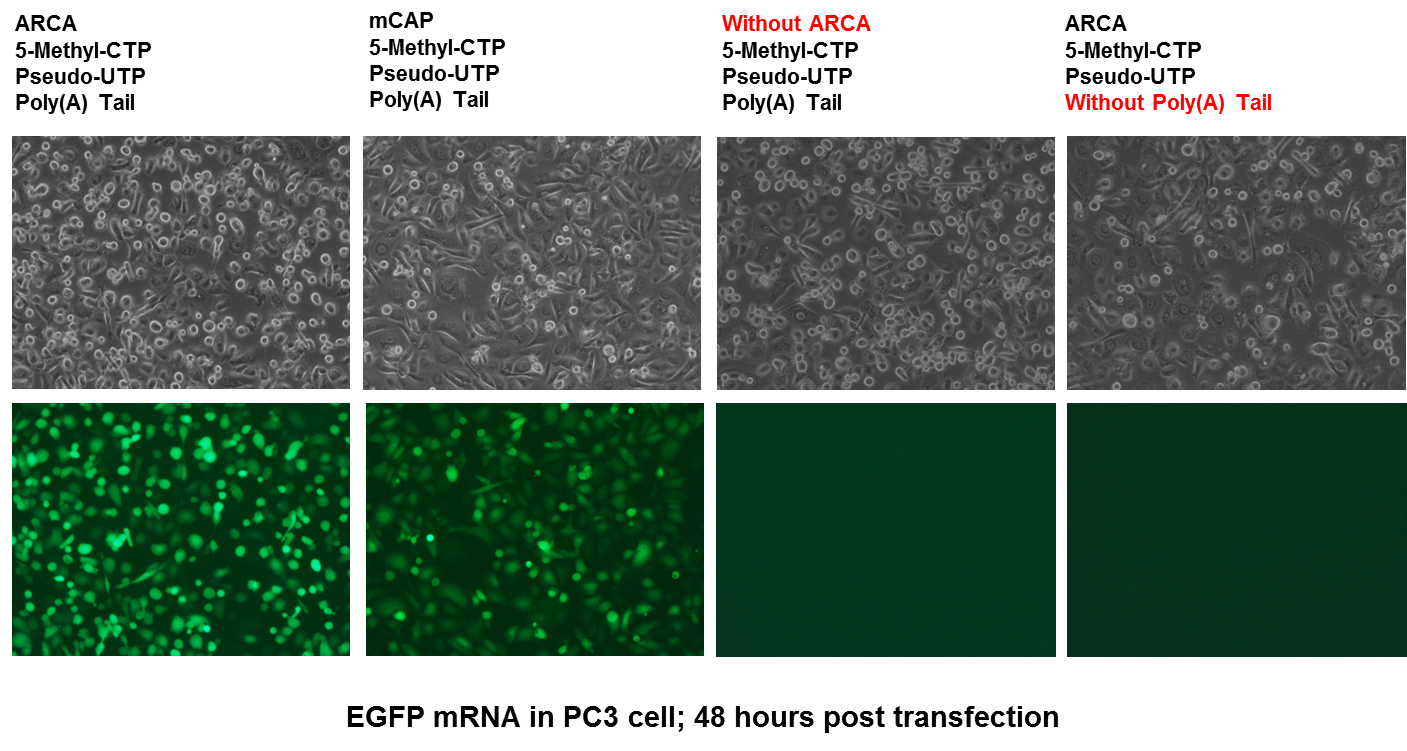
mRNA Purification
mRNAs transcribed in vitro by T7 RNA polymerase may contain various contaminants, such as short RNAs produced by abortive initiation events, double-stranded (ds)RNAs generated by self-complementary 3’extension, as well as unincorporated nucleoside triphosphates, small abortive transcripts and plasmid template. Certain RNA sequences even induce high levels immunogenicity.
APExBIO offers purification service to remove the contaminants of modified nucleotide-containing mRNA, thus increase the processing efficiency for downstream applications.
Silica-gel Membrane Spin Column Purification:
It is a solid phase extraction technique for fast nucleic acid purification. mRNA can be bound to solid phase of silica-gel membranes under certain conditions, with subsequent washing and elution steps in water or TE pH 7. This method eliminates most proteins, DNA and NTPs.
HPLC purification by ÄKTA avant system:
mRNA can be purified by HPLC (ÄKTA avant system) using column matrix of alkylated non-porous polystyrene-divinylbenzene copolymer microspheres and optimized buffer system, followed by mRNA analyses and mRNA isolation from column fractions.
HPLC purification removes dsRNA and other contaminants from in vitro synthesized modified nucleotide-containing mRNAs, yielding mRNA with the high level of translation without generation of immunogenicity or RNA sensor activation.
mRNA and long RNA products
APExBIO supplies the best quality mRNA and long RNA. This new product lines involve custom synthesis of mRNA and long RNA (up to multiple kilobases) with a wide array of modification services at scales ranging from micrograms to milligrams. The mRNA can be generated from DNA templates provided by our customers or we can provide a full service from the ground up. We offer mCAP or ARCA capping or modified nucleotides implication for all our standard mRNA transcripts.
All of our mRNA products offer:
Validation:

| Related Products | |||
|---|---|---|---|
| Cat.No. | Product Name | Cat.No. | Product Name |
| R1001 | ARCA EGFP mRNA | R1002 | ARCA EGFP mRNA (5mCTP, ψUTP) |
| R1003 | mCAP EGFP mRNA | R1004 | mCAP EGFP mRNA (5mCTP, ψUTP) |
| R1005 | Firefly Luciferase mRNA (ARCA, 5mCTP, ψUTP) | R1006 | SpCas9 mRNA (ARCA, 5mCTP, ψUTP) |
| R1007 | ARCA EGFP mRNA (5-moUTP) | R1008 | ARCA Cy3 EGFP mRNA (5-moUTP) |
| R1009 | ARCA Cy5 EGFP mRNA (5-moUTP) | R1010 | EZ Cap™ Cy5 Firefly Luciferase mRNA (5-moUTP) |
| R1011 | EZ Cap™ Cy5 EGFP mRNA (5-moUTP) | R1012 | Firefly Luciferase mRNA (ARCA, 5-moUTP) |
| R1013 | EZ Cap™ Firefly Luciferase mRNA (5-moUTP) | R1014 | ARCA Cas9 5-moUTP |
| R1015 | EZ Cap™ Cas9 5-moUTP | R1016 | EZ Cap™ EGFP mRNA (5-moUTP) |
| R1017 | EZ Cap™ mCherry mRNA (5mCTP, ψUTP) | R1018 | EZ Cap™ Firefly Luciferase mRNA |
| B8178 | EZ Cap™ Reagent AG (3' OMe) | ||
Antibody Drugs and Vaccine Development Related Products
| Cat.No. | Product Name | Information |
| B8293 | ddhCTP | Chain terminator for the RNA-dependent RNA polymerases. Novel antiviral nucleotide molecules. |
| B8362 | 2,3-cGAMP | Immune adjuvant, can specifically activate STING pathway, stimulate innate immunity and accelerate antibody production. |
| BC1001 | Human B Cell Culture and Expansion Kit | Used for activation and expansion of human B cells. |
| BC1002 | 3T3-msCD40L Cell Lines | 3T3-CD40L cells can be co-cultured with B cells to aid B cell expansion. |